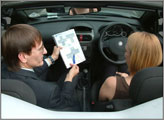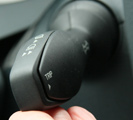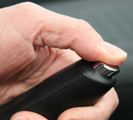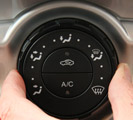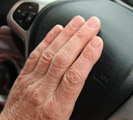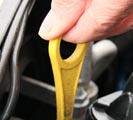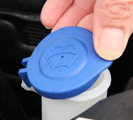Show Me / Tell Me
At the beginning of your driving test, normally after the eyesight test, you will be asked two of the following questions. Please note that the questions using the words "Tell Me" only require you to explain the answer, while questions using the words "Show Me" require you to actually demonstrate the answer.
Click on each question to reveal the answer.
Question 1 ... Show me how you would check that the direction indicators are working.
Answer 1 ...Applying the indicators or hazard warning switch and check functioning of all indicators. (You may need to switch ignition on, prompt not to start engine).
TIP - Most cars will not need to have the ignition switched on to activate the hazard switch, so it should be simple to lean into the car, switch it on, walk around the car checking all 4 main indicators (there are also indicators on the front wings and/or the door mirrors), and then lean into the car to switch off the hazard switch.
Question 2 ... Show me how you would check that the brake lights are working on this car. (I can assist you, if you need to switch the ignition on, please don't start the engine).
Answer 2 ... Operate brake pedal, make use of reflections in windows, garage doors, etc, or ask someone to help. (You may need to switch ignition on, but do not start engine).
Question 3 ... Show me how you would check that the power assisted steering is working before starting a journey.
Answer 3 ... If the steering becomes heavy the steering may be faulty. Before starting a journey two simple checks can be made:
1) Gentle pressure on the steering wheel, maintained whilst the engine is started, should result in slight but noticeable movement as the system begins to operate.
2) Turning the steering wheel after just moving off will give an immediate indication that the power assisted steering is functioning correctly.
Question 4 ... Show me how you would check the parking brake (handbrake) for excessive wear, make sure you keep safe control of the vehicle.
Answer 4 ... Apply footbrake firmly. Demonstrate by applying parking brake (handbrake) so that when it is fully applied it secures itself, and is not at the end of the working travel.
TIP - Keep the button pressed in when aplying the handbrake so that you do not hear the ratchet noise.
Question 5 ... Show me. Open the bonnet, identify where you would check the engine oil level and tell me how you would check that the engine has sufficient oil.
Answer 5 ... Identify dipstick / oil level indicator, describe check of oil level against the minimum/maximum markers.
Question 6 ... Show me. Open the bonnet, identify where you would check the engine coolant level and tell me how you would check that the engine has the correct level.
Answer 6 ... Identify high/low level markings on header tank where fitted or radiator filler cap, and describe how to top up to correct level.
Question 7 ... Show me. Open the bonnet, identify where the brake fluid reservoir is and tell me how you would check that you have a safe level of hydraulic brake fluid.
Answer 7 ... Identify reservoir, check level against high/low markings.
Question 8 ... Show me how you would check that the horn is working (off road only).
Answer 8 ... Show me how you would check that the horn is working (off road only).
Question 9 ... Show me how you would clean the windscreen using the windscreen washer and wipers.
Answer 9 ... Operate control to wash and wipe windscreen (turn ignition on if necessary.
Question 10 ... Show me how you would set the demister controls to clear all the windows effectively, this should include both front and rear screens.
Answer 10 ... Set all relevant controls including; fan, temperature, air direction / source and heated screen to clear windscreen and windows. Engine does not have to be started for this demonstration.
TIP - Front air direction should be set to demist- usually this looks like a windscreen with 'wavey' lines on it, temperature to warm or hot- usually red, and fan speed should be set to medium or high- often cars have numbers 0-5. Rear demist will be a button usually in the centre of the dashboard. Air conditioning can be used to good effect for demisting the windscreen in the winter as the air is dryer.
Question 11 ... Show me how you would switch on the rear fog light(s) and explain when you would use it/them. (No need to exit vehicle)
Answer 11 ... Operate switch (turn on dipped headlights and ignition if necessary). Check warning light is on. Explain use.
TIP - Rear foglight should be used when visability is seriously reduced. It must be switched off as soon as visibility is improved to avoid dazzling other drivers, especially at night.
Question 12 ... Show me how you switch your headlight from dipped to main beam and explain how you would know the main beam is on whilst inside the car.
Answer 12 ... Operate switch (with ignition or engine on if necessary), check with main beam warning light.
TIP - Main beam warning light will be a blue light usually close to the main instruments.
Question 13 ... Tell Me Tell me how you would check that the brakes are working before starting a journey.
Answer 13 ... Brakes should not feel spongy or slack. Brakes should be tested as you set off. Vehicle should not pull to one side.
TIP - Spongey brakes are caused by air in the hydraulic system, and the brakes should be bled immediately, and the cause of air ingress investigated. Pulling brakes may be caused by one brake being faulty- usually seized- which results in the effect of the 'good' brake pulling the car to one side.
Question 14 ... Tell Me where the windscreen washer reservoir is and tell me how you would check the windscreen washer level.
Answer 14 ... Identify reservoir and explain how to check level.
TIP - On some cars you can see the level in the bottle, but on many the bottle is concealed, and all that you can see is the filler neck. In this case you could say that you would open the filler cap and look down for a level or just try topping up the bottle with screenwash/water.
Question 15 ... Tell Me where you would find the information for the recommended tyre pressures for this car and how tyre pressurer should be checked.
Answer 15 ... Manufacturer’s guide, use a reliable pressure gauge, check and adjust pressures when tyres are cold, don’t forget spare tyre, remember to refit valve caps.
Question 16 ... Tell Me how you make sure your head restraint is correctly adjusted so it provides the best protection in the event of a crash.
Answer 16 ... The head restraint should be adjusted so the rigid part of the head restraint is at least as high as the eye or top of the ears, and as close to the back of the head as is comfortable. N.B. Some restraints might not be adjustable.
Question 17 ... Tell Me how you would check the tyres to ensure that they have sufficient tread depth and that their general condition is safe to use on the road.
Answer 17 ... No cuts and bulges, 1.6mm of tread depth across the central ¾ of the breadth of the tyre and around the entire outer circumference.
Question 18 ... Tell me how you would check that the headlights & tail lights are working. (No need to exit vehicle)
Answer 18 ... Operate switch (turn on ignition if necessary), then walk round vehicle. As this is a "Tell Me" question, there is no need to physically check the lights.
Question 19 ... Tell me how you would know if there was a problem with your anti-lock braking system.
Answer 19 ... A warning light should illuminate if there is a fault with the anti lock braking system.
